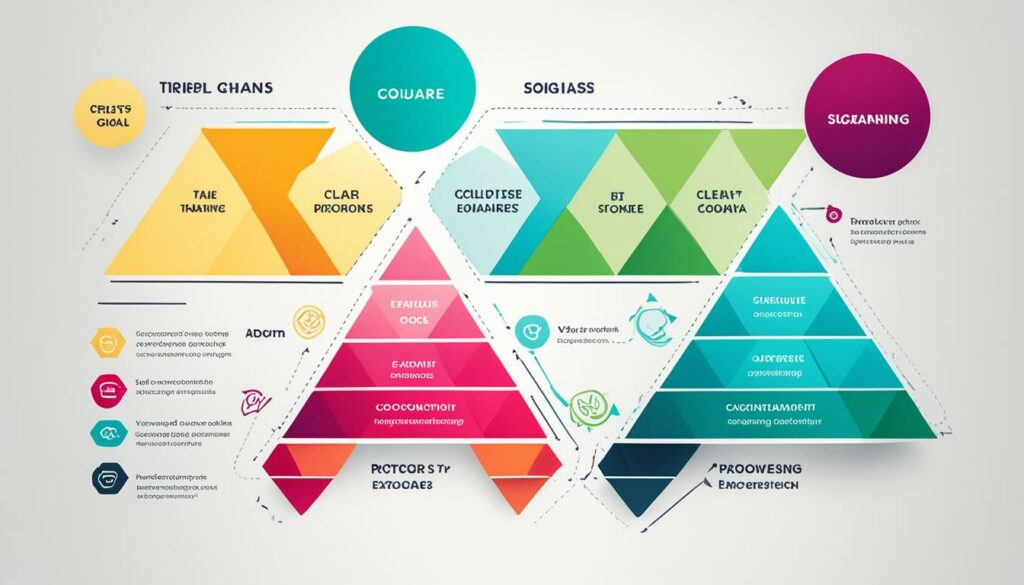
Crafting Compelling Messages for Your Product

How often do you find yourself drawn to a product or service because of its captivating message? It’s not a coincidence. Crafting compelling messages is a strategic process that can make or break your product’s success. It’s the art of positioning your product in the minds of your target audience and communicating its value effectively.
But what does it take to create a message that grabs attention, resonates with your audience, and compels them to take action? How do you make sure your message stands out in a crowded marketplace?
In this article, we will explore the key elements of crafting compelling messages for your product. From understanding your audience’s needs and defining your objectives to addressing those needs with a clear and concise message, we’ll guide you through the process of creating a powerful product messaging strategy.
Key Takeaways:
- Crafting compelling messages is crucial for effective product positioning and messaging strategy.
- Understand your audience’s needs and define your objectives to create messages that resonate.
- Address your audience’s needs, highlight your product’s value proposition, and use emotion to connect.
- Keep your messages clear, concise, and jargon-free for maximum impact.
- Leverage storytelling techniques and tailor messages for different channels to engage your audience.
Understanding Your Audience’s Needs
Before crafting your message, it is crucial to gain a deep understanding of your target audience’s needs. By identifying the problems they are facing and the solutions they are seeking, you can create messaging that is relevant, impactful, and resonates with them.
By understanding your audience’s needs, you can develop a message that addresses their pain points and offers solutions. This knowledge helps you tailor your communication to meet their expectations and deliver value. Additionally, it allows you to position your product or service as the ideal solution, making your message more compelling.
Investing time and effort in understanding your audience’s needs provides the foundation for creating effective messaging that drives engagement and action. By aligning your message with their desires and goals, you can establish a strong connection with your target audience and differentiate yourself from competitors.
“Understanding your audience’s needs is the first step towards creating powerful messaging that resonates and influences their decisions.”
The Key Steps to Understanding Your Audience’s Needs:
- Conduct thorough market research to identify your target audience’s demographics, psychographics, and preferences.
- Engage in conversations with your target audience through surveys, interviews, and social media interactions to gather insights into their pain points.
- Analyze customer feedback, reviews, and testimonials to understand their experiences and expectations.
- Monitor industry trends and competitor activities to identify emerging needs and opportunities.
Using these steps, you can create a comprehensive profile of your target audience, enabling you to tailor your messaging to meet their specific needs and preferences. Remember, effective communication starts with understanding your audience’s needs.
Defining Objectives
When crafting your message, it’s crucial to have clear objectives in mind. Clearly defining your message objectives will help guide your content and ensure that it is focused and effective. By determining the desired action you want your audience to take, you can create a compelling call to action that drives engagement and conversions.
Consider what specific action you want your audience to take after reading your message. Do you want them to make a purchase, sign up for a demo, or subscribe to your newsletter? Defining your desired action will help shape the content and tone of your message, making it more persuasive and impactful.
“Your message objectives provide a roadmap for your content, guiding you towards the desired outcome. Without clear objectives, your message may lack direction and fail to achieve the results you’re aiming for.”
Once you have defined your objectives and desired action, it’s essential to incorporate a strong call to action in your message. The call to action should clearly communicate what step your audience should take next and provide them with an easy way to do so. Whether it’s a button to click, a link to follow, or a phone number to call, make sure your call to action is prominent and easily accessible.
To illustrate the importance of clear objectives, let’s take a look at an example:
| Message Objective | Desired Action |
|---|---|
| Promote a new product | Encourage customers to make a purchase |
In the example above, the message objective is to promote a new product, and the desired action is to encourage customers to make a purchase. By keeping these objectives in mind, you can craft a message that highlights the product’s benefits, addresses customer needs, and ultimately motivates them to take action.

Defining clear objectives and incorporating a strong call to action are essential components of crafting compelling messages that drive results. In the next section, we will explore how to effectively address your audience’s needs and align your message with their expectations.
Crafting Messages That Address Needs and Objectives
When it comes to crafting effective messages for your product, it’s essential to address your audience’s needs while aligning with your objectives. By clearly articulating how your product or service solves their problems, you can create messaging that resonates and motivates action.
Highlighting the value proposition and unique benefits of your product is key to capturing your audience’s attention. Showcasing the positive impact and value your product offers will help differentiate it from competitors and build trust with your potential customers.
For example, if you have a skincare product, you can emphasize how it solves common skincare problems such as acne or dryness. Through your messaging, you can communicate the benefits of using your product, such as clearer and healthier skin.
Here’s an example of how you can format your message to address needs and objectives:
“Are you tired of dealing with stubborn acne? Our revolutionary skincare product is specially formulated to target acne-prone skin, effectively reducing breakouts and promoting a clear complexion. Say goodbye to blemishes and hello to smoother, healthier-looking skin. Take action today and achieve the confidence you deserve!”
By crafting messages that directly address your audience’s needs and align with your objectives, you can create a compelling value proposition that motivates action and drives conversions.
Highlighting Product Benefits
| Product Benefits | Solving Problems | Value Proposition |
|---|---|---|
| Clears acne-prone skin | Addresses persistent acne issues | Promotes clearer, healthier skin |
| Reduces fine lines and wrinkles | Targets signs of aging | Achieves youthful-looking skin |
| Hydrates and nourishes skin | Combats dryness and dullness | Restores moisture and radiance |
By showcasing the product’s benefits, how it solves problems, and its value proposition, you can effectively communicate the value customers can expect from your product.
Using Emotion to Connect
Emotions have a powerful impact on decision-making. When crafting your message, it is essential to use emotional triggers to connect with your audience on a deeper level. By tapping into their desires, aspirations, and fears, you can create a strong emotional connection that makes your message more persuasive and memorable.
One effective way to connect emotionally with your audience is to tell stories that resonate with them. Stories have a unique ability to evoke emotions and create a sense of empathy. By sharing relatable narratives, you can engage your audience and make them feel connected to your message.
Another strategy is to use powerful and descriptive language that triggers emotions. Choose words that elicit specific emotional responses and convey the value and impact of your product or service. By doing so, you can create an emotional bond with your audience, increasing the likelihood of them taking the desired action.
“The customer’s perception is your reality.” – Kate Zabriskie
Furthermore, visual content can also be a powerful tool for evoking emotions. Images and videos that convey the desired emotional response can greatly enhance your message’s effectiveness. Use visuals that align with your brand and the emotions you want to evoke, reinforcing the emotional connection with your audience.
Below is an example of how emotion can be used to connect with an audience:

| Emotional Trigger | Desired Response |
|---|---|
| Fear | Take immediate action to avoid negative consequences. |
| Excitement | Feel motivated and eager to explore further. |
| Trust | Feel confident and secure in their decision-making. |
By understanding and leveraging emotional triggers, you can forge a stronger connection with your audience and influence their decision-making process. Remember to align the emotional tone with your target audience and goals, ensuring that your message delivers the desired impact.
Keeping It Clear and Concise
In order to effectively communicate your message and convey its value, it is essential to keep your messaging clear and concise. By avoiding jargon and technical terms that might confuse your audience, you can ensure that your message is easily understood and resonates with your target market.
When crafting your message, strive for simplicity and clarity. Use plain language that allows your audience to quickly grasp the meaning and purpose of your communication. Keep your sentences short and straightforward, avoiding unnecessary complexity or verbosity.
“Clear messaging is the key to grabbing your audience’s attention and keeping them engaged. By stripping away unnecessary jargon, you create a message that cuts through the noise and delivers your value proposition effectively.”
By focusing on clear messaging, you enable your audience to easily comprehend and absorb your message, increasing the likelihood of them taking the desired action. A concise communication style demonstrates respect for your audience’s time and attention, making your message more compelling and impactful.
Key Takeaways:
- Avoid using jargon or technical terms that might confuse your audience.
- Keep your sentences short and straightforward.
- Use plain language that is easily understood by your target market.
Leveraging the Power of Storytelling
Incorporate storytelling into your message to make it more captivating and engaging. By utilizing the art of storytelling, you can create a powerful and memorable narrative that resonates with your audience, building anticipation and inspiring them to take action.
Storytelling has the ability to ignite emotions and create a deeper connection with your audience. It allows you to present your product or service in a way that captures attention and leaves a lasting impression. A captivating narrative has the potential to evoke excitement, curiosity, or empathy, ultimately driving engagement and influencing purchasing decisions.
When crafting your message, consider the elements of a great story: a relatable protagonist, clear conflict, and a satisfying resolution. These components help create a narrative arc that keeps your audience engaged from beginning to end. By presenting your product or service as the solution to their challenges, you can create a sense of urgency and position yourself as the hero of their story.
Storytelling also enables you to convey complex ideas and information in a more digestible format. By structuring your message as a story, you guide your audience through a logical sequence of events, making it easier for them to understand and remember key details.
“A story can change the way people think, feel, and act. It has the power to capture attention, build trust, and make a lasting impact.”
To further enhance your storytelling, consider incorporating visuals, such as images or videos, to support your narrative. Visual cues can reinforce the emotions and messages conveyed in your story, making it even more compelling and memorable.

By leveraging the power of storytelling, you can create a message that not only informs but also entertains, engages, and inspires action. Craft a captivating narrative that resonates with your audience, and watch as they become active participants in your brand story.
Tailoring Messages for Different Channels
When it comes to effective communication, understanding the significance of multi-channel messaging is paramount. Your target audience interacts with various communication channels and platforms, each with its own unique characteristics and preferences. To maximize audience engagement and ensure your message reaches its intended recipients, it is crucial to tailor your messaging for each specific channel.
Do your research and identify the communication channels your target audience frequents. Is it social media platforms like Facebook and Twitter? Email newsletters? Blogs or forums? By understanding where your audience prefers to receive information, you can adapt your messaging accordingly.
Consider the language and tone that resonates with your target audience on each channel. Are they more receptive to a formal or informal style of communication? Do they prefer concise and succinct messages, or are they likely to engage with longer, detailed content?
| Communication Channel | Key Characteristics | Appropriate Messaging Strategy |
|---|---|---|
| Social Media | Short attention spans, visual content, interactive engagement | Use compelling visuals, concise captions, and calls-to-action to capture attention and encourage sharing and interaction |
| Direct and personal approach, longer attention span | Create personalized and tailored messages that address the recipient by name and provide detailed information about your product or service | |
| Blogs or Forums | In-depth content, community engagement | Develop informative blog posts or forum threads that address common pain points and encourage discussion and interaction with your audience |
Remember, it’s not just about adapting the language and style of your messages. You should also consider the format and content delivery methods. For instance, visuals and videos may work best on social media platforms, while detailed written content may be better suited for blogs or newsletters.
By tailoring your messages for different channels, you can create a personalized and engaging experience for your audience. This approach demonstrates that you understand their communication preferences and strengthens their connection with your brand. It also increases the likelihood of your audience taking the desired action, whether it’s making a purchase, signing up for a newsletter, or engaging with your content.
Remember, effective multi-channel messaging is a continuous process. Regularly monitor and analyze the performance of your messages across various channels. Use data-driven insights to make informed decisions and optimize your messaging strategy for maximum audience engagement and conversion rates.
Testing and Optimization
Continuously test and optimize your messages to improve their effectiveness. By employing A/B testing and data analysis, you can measure the impact of different messaging strategies and make data-driven decisions to refine your messages and increase their impact on your target audience.
Message testing is a crucial process in ensuring the success of your product positioning and messaging strategy. By testing different variations of your messages, you can gather valuable insights on what resonates best with your audience and fine-tune your messaging accordingly.
Optimization strategies play a vital role in enhancing the performance of your messages. Through careful analysis of data, you can identify patterns, trends, and areas for improvement. By leveraging the power of data analysis, you can uncover hidden opportunities and optimize your messaging for maximum impact.
Utilize A/B testing to compare the performance of different messaging strategies. Create two or more variations of your message and present them to different segments of your target audience. Analyze the results to identify which version performs better in terms of engagement, conversions, and overall effectiveness.
Data analysis is an essential part of message testing and optimization. Analyzing data on key metrics such as open rates, click-through rates, conversion rates, and customer feedback provides valuable insights into the effectiveness of your messages. Use these insights to iterate on your messaging strategy and continuously improve its impact.
Remember to test not only the content of your messages but also the format, timing, and delivery channels. Experiment with different headlines, call-to-action buttons, imagery, and personalization elements to determine what resonates best with your audience.
Example A/B Test Results:
| Variation | Open Rate | Click-through Rate | Conversion Rate |
|---|---|---|---|
| Variation A | 25% | 10% | 5% |
| Variation B | 32% | 12% | 7% |
By analyzing the results of an A/B test, you can see that Variation B had a higher open rate, click-through rate, and conversion rate compared to Variation A. This indicates that the messaging elements in Variation B resonated better with the target audience, making it a more effective choice.
Based on this data, you can optimize your messaging strategy by incorporating the successful elements from Variation B into future campaigns. Continuously testing and optimizing your messages will allow you to refine and fine-tune your messaging strategy over time, leading to improved audience engagement and better overall results.
Conclusion
Crafting compelling messages is the key to effective product positioning and a successful messaging strategy. By understanding your audience’s needs and defining clear objectives, you can create messages that truly resonate and drive engagement.
A successful messaging strategy starts with a deep understanding of your target audience. Identify their pain points and the solutions they seek. Address these needs in your messaging, showcasing how your product or service can solve their problems and provide value.
Emotion plays a significant role in connecting with your audience. Incorporate emotional triggers into your messages to establish a strong bond. Tap into their desires, aspirations, and fears to create a lasting impact and motivate action.
Continuous testing and optimization are crucial for refining your messaging strategy. Use data analysis and A/B testing to measure the effectiveness of different messaging approaches. Make data-driven decisions to improve your messages over time and ensure they deliver maximum impact.





























